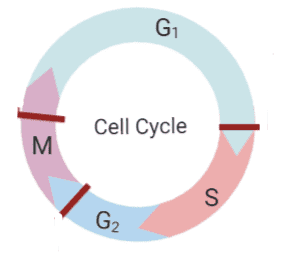
Cell in \[G0\] phase of cell cycle
A. Exit cell cycle
B. Enter cell cycle
C. Suspend cell cycle
D. Terminate cell cycle
Answer
549k+ views
Hint:Cell cycles, or cell-division cycles, are events that occur within a cell in sequence and result in the division into two daughter cells. These sequences of events include the replication of DNA and its organelles in a process called cell division, as well as the partitioning of its cytoplasm and other components into two daughter cells. Approximately one billion cells die every hour, and one billion cells are produced in the body.
Complete answer:
Four different stages of the cell cycle: The \[G1\] phase, the S phase (synthesis), the \[G2\] phase (collectively referred to as the interphase), and the M phase (mitosis and cytokinesis). The M step is a mixture of two processes: -mitosis, in which the nucleus of the cell divides, and cytokinesis, in which the cytoplasm of the cell divides, into two daughter cells. Cells that have stopped dividing semi-permanently or reversibly are part of a cycle called the \[G0\] phase.

In an adult animal, certain cells do not differentiate, e.g., nerve cells, whereas several cells often divide only to replace cell loss due to damage or cell death.
This type of cell is still in the \[G0\] phase. The cell cycle's \[G0\] phase is also known as the quiescent period.
The cell remains metabolically active in this phase but does not proliferate until it is called upon to do so. Cells stop the cell cycle for some time in the \[G0\] phase of the cell cycle, but they do not terminate the cell cycle entirely. They leave the cell cycle when a cell reaches the \[G0\] process.
The correct answer, therefore, is the A-exit of the cell cycle.
Note: The cell cycle starts with the \[G0\] step. Non-dividing cells are added from \[G1\] to the \[G0\] state and may remain at \[G0\] for long periods of time. Some of the cells are semi-permanently part of the \[G0\] pathway and are understood as post-mitotic cells.
Complete answer:
Four different stages of the cell cycle: The \[G1\] phase, the S phase (synthesis), the \[G2\] phase (collectively referred to as the interphase), and the M phase (mitosis and cytokinesis). The M step is a mixture of two processes: -mitosis, in which the nucleus of the cell divides, and cytokinesis, in which the cytoplasm of the cell divides, into two daughter cells. Cells that have stopped dividing semi-permanently or reversibly are part of a cycle called the \[G0\] phase.

In an adult animal, certain cells do not differentiate, e.g., nerve cells, whereas several cells often divide only to replace cell loss due to damage or cell death.
This type of cell is still in the \[G0\] phase. The cell cycle's \[G0\] phase is also known as the quiescent period.
The cell remains metabolically active in this phase but does not proliferate until it is called upon to do so. Cells stop the cell cycle for some time in the \[G0\] phase of the cell cycle, but they do not terminate the cell cycle entirely. They leave the cell cycle when a cell reaches the \[G0\] process.
The correct answer, therefore, is the A-exit of the cell cycle.
Note: The cell cycle starts with the \[G0\] step. Non-dividing cells are added from \[G1\] to the \[G0\] state and may remain at \[G0\] for long periods of time. Some of the cells are semi-permanently part of the \[G0\] pathway and are understood as post-mitotic cells.
Recently Updated Pages
Why are manures considered better than fertilizers class 11 biology CBSE

Find the coordinates of the midpoint of the line segment class 11 maths CBSE

Distinguish between static friction limiting friction class 11 physics CBSE

The Chairman of the constituent Assembly was A Jawaharlal class 11 social science CBSE

The first National Commission on Labour NCL submitted class 11 social science CBSE

Number of all subshell of n + l 7 is A 4 B 5 C 6 D class 11 chemistry CBSE

Trending doubts
Differentiate between an exothermic and an endothermic class 11 chemistry CBSE

10 examples of friction in our daily life

One Metric ton is equal to kg A 10000 B 1000 C 100 class 11 physics CBSE

Difference Between Prokaryotic Cells and Eukaryotic Cells

1 Quintal is equal to a 110 kg b 10 kg c 100kg d 1000 class 11 physics CBSE

State the laws of reflection of light




